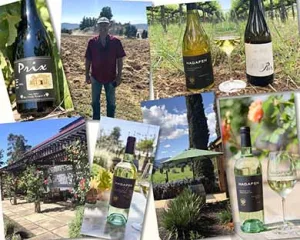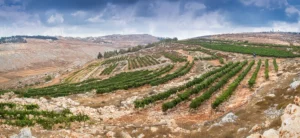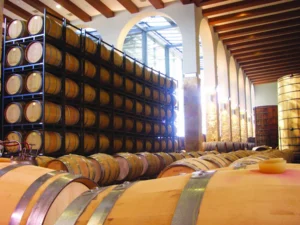All the talk of recent weeks was of the 50th year anniversary since the Six Day War and the unification of Jerusalem. This was also the 50th anniversary of the Golan Heights coming into our hands, and from a wine point of you this was by far the most seminal event.
The Golan Heights proved to be the theatre which fermented the quality revolution of Israeli wine, changing the fortunes of our wine industry forever and bringing back a golden age of Israeli wine for the first time in 2,000 years. The strategic Golan Heights became Golan wine country.
What is special about the Golan Heights is its altitude and terroir. It is a volcanic plateau that is overlooked by the snow covered Mount Hermon and itself overlooks the beautiful Sea of Galilee. Its elevation rises to 1,200 meters above sea level. As most of Israel is on a latitude with North Africa, it can be hot and humid. Climb and you mitigate the problem of latitude, enjoy a cooler climate, a longer growing season and gain the potential for greater freshness and complexity in the wines. As for the soil, it is volcanic tuff with a great deal of that black basalt stone you see everywhere on the Golan. It provides excellent drainage and good minerality.
Israel’s wine history BG, (‘Before Golan’), was far from distinguished. I remember baked wines lacking fruit. I used to wonder if they were even made from grapes. White wines were more often than not yellowing and oxidized. At the time, a famous wine writer wrote about an Israeli Sauvignon Blanc, describing it as probably the nastiest wine he had ever tasted. Israel’s most famous wine export was Adom Atik.
When the Golan Heights came into Israel’s hands, the potential for a wine revolution was at hand, but we did not know it. However Professor Cornelious Ough from the University of California at Davis did. He saw the sprouting apple industry and thought wine grapes would also thrive there. The pioneers that planted those first vineyards in 1976 laid the roots of the wine revolution that was to follow.
In 1983 the Golan Heights Winery was formed by a partnership of four kibbutzes and four moshavs. They sought expertise from California in the form of a winemaking consultant Peter Stern and a series of young winemakers. Thus the ‘New World’ wine revolution, which basically taught how to make wine in hot countries, was imported to Israel.
The Golan Heights Winery elevated the importance of the vineyard and vineyard management. The decision making process in the vineyard of how to prune and when to harvest, for the first time passed from the grower to the winery. Previously vineyards were not considered that important. The grower and winemaker both had jobs to do but they would never meet. A winemaker would never be seen in a vineyard. Today it is understood one makes the wine in the vineyard.
At the winery the investment was in technology and everything was geared to quality. Must chillers to reduce temperatures, gentle bladder presses, computer-controlled stainless steel tanks allowing absolute temperature control, expensive small oak barrels and a fanatical cleaning regime signposted the way to others.
The way they marketed the new wines could also be taught in schools. Quality labelling, pricing up, focusing on export and making the product rare in Israel was innovative and effective.
There are four wines that for me represent the life of this pioneering winery. The first is the Yarden Cabernet Sauvignon, the finest ambassador of Israeli wine. This for me represents the 1980’s. Then it was the finest wine in Israel. Today it remains the best value varietal cabernet in Israel. This was the wine that set standards for the country. It has been Israel’s most consistent award winner in international competitions. It ruled the roost as Israel changed from a white wine drinking country to a red one, and spread the word about the new quality of Israeli wine abroad. I was in the wine trade in England when I heard with amazement that the Yarden Cabernet Sauvignon 1984 had won a gold medal and the Winiarski Trophy at the International Wines & Spirit Competition in London in 1987. I remember the shock and pride in equal measure.
The 1990’s is for me the era of Yarden Katzrin, the first ‘super’ Israeli prestige wine. It became a cult wine because of its rarity, quality and it was strictly allocated. It was only produced in especially good vintages. Recently I tasted a wine presented by Victor at the launch of the Katzrin 2013. He asked how old it was. With a light browning at the edge of the rim, I assumed it had some age but it tasted quite young. I thought is may be 10-12 years old but was so wrong. It was the Yarden Katzrin 1993, no less than 24 years old and showing astonishing youth. It is relatively rare for an Israeli wine to last more than 12-15 years, but Golan wines are built to last and this was the ultimate, vivid example. It remains the most expensive prestige blend in the country costing 450 shekels a bottle.
The 2000’s for me was symbolized by Mount Hermon Red. This was the time when the winery became a 6 million bottle operation, which is big by any standards. Suddenly volume and sales became important to the winery which had previously been preoccupied solely with quality and excellence. Of course they rose to the occasion magnificently. Mt. Hermon Red became the largest selling wine in the country by far, way ahead of anything the larger wineries (Barkan & Carmel) could muster. Fruit forward, full of flavor, easy drinking and great value, the wine went from strength to strength. The labelling which gave the customer to understand they were drinking the aspirational Yarden also helped the ascending popularity.
The 2010’s for me is the era of Yarden Blanc de Blancs. This is Israel’s finest sparkling wine. The quality gap that the Golan enjoyed in the eighties and nineties, no longer exists to the same extent. There are a handful of small boutique wineries today making very fine wines indeed. Furthermore the larger wineries have also responded to the gauntlet thrown down by the Golan Heights Winery so long ago. The wine market worships all that is new or small and is in love with gimmicks. So the older kid on the block may be regarded as the establishment by the self-regarded wine intelligentsia. There are those amongst the chattering classes who feel the winery has slipped a few notches in recent years. However even those doubting Thomas’s agree that the Yarden Blanc de Blancs is one of the outstanding Israeli wines … so this wine in particular continues to fly the flag.
Much of the ongoing success is due to the winemaker Victor Schoenfeld. He was appointed chief winemaker in 1992. With his understanding of technology, passion for wine and rigorous standards he has maintained the winery’s quality over the last 25 years. He has managed to steer the winery to be technologically the most advanced in Israel, maintaining standards , despite increasing production.
Schoenfeld’s wines have won awards at the very highest level, whether white, red, sparkling or desert wines. I once remember hosting the famous Japanese sommelier Shinya Tasaki at the winery when I worked there. He asked Victor what his favorite wine was that he made. I understood the question. Most winemakers have a blend or variety that is a bit more of their baby than the others. It is always instructive to know.
Victor blinked and thought, and seemed to be having difficulty in giving an answer. Then he said hesitantly: “I am never happy with any wine I make”. What he meant was he was seeking perfection and always saw the faults. It was a totally unscripted, honest moment, which said everything about Victor. The pursuit of excellence, striving for perfection and never being satisfied are his hallmarks that have kept the winery on top.
The elephant in the room is of course the politics. How the Golan Heights is still regarded as Occupied Territory beats me and defies common sense. The only thing in common with the West Bank is that it came into Israel’s hands in 1967. There is no moral problem on the Golan Heights. It is bereft of Palestinians. In the past President Assad was not King Hussein, and so to whom did the world think the Golan should be given back to? Now with the breakup of Syria the idea is absurd, but the political labelling lives on. To its credit the winery continues unhindered. However the situation remains a pathetic failure of Israeli political diplomacy.
Straight after the Six Day War, who would have thought that the Golan Heights would become most famous for its wine? The Golan Heights Winery was the catalyst that took Israel into a new promised land of wine quality and Yarden remains to this day the visual ambassador of brand Israel around the world.
_______________________________________________________________
Three of the best value wines from the Golan Heights Winery today are the following:
Gamla Brut Shmura NV Quality sparkling wine. One of the best buys in Israeli wine today. A hint of toast, a touch of lime and spring flowers in the background, the wine has piercing acidity and a refreshing finish. PRICE: 60 ILS
Yarden Pinot Gris 2015 Medium bodied white wine showing tropical fruit character with more than a hint of green apple and lime. It has a refreshing balanced finish. PRICE: 79 ILS
Yarden Cabernet Sauvignon 2013 Deep colored and full bodied with aromas of blackcurrant, blackberry and ripe plum and a nicely integrated herbal character. Complex with a long finish. Consistent quality and value. PRICE: 115 ILS
Adam Montefiore has been advancing Israeli wines for over 30 years. He is known as the ‘English voice of Israeli wine’ and writes his regular Wine Talk column for the Jerusalem Post.
www.adammontefiore.com



















